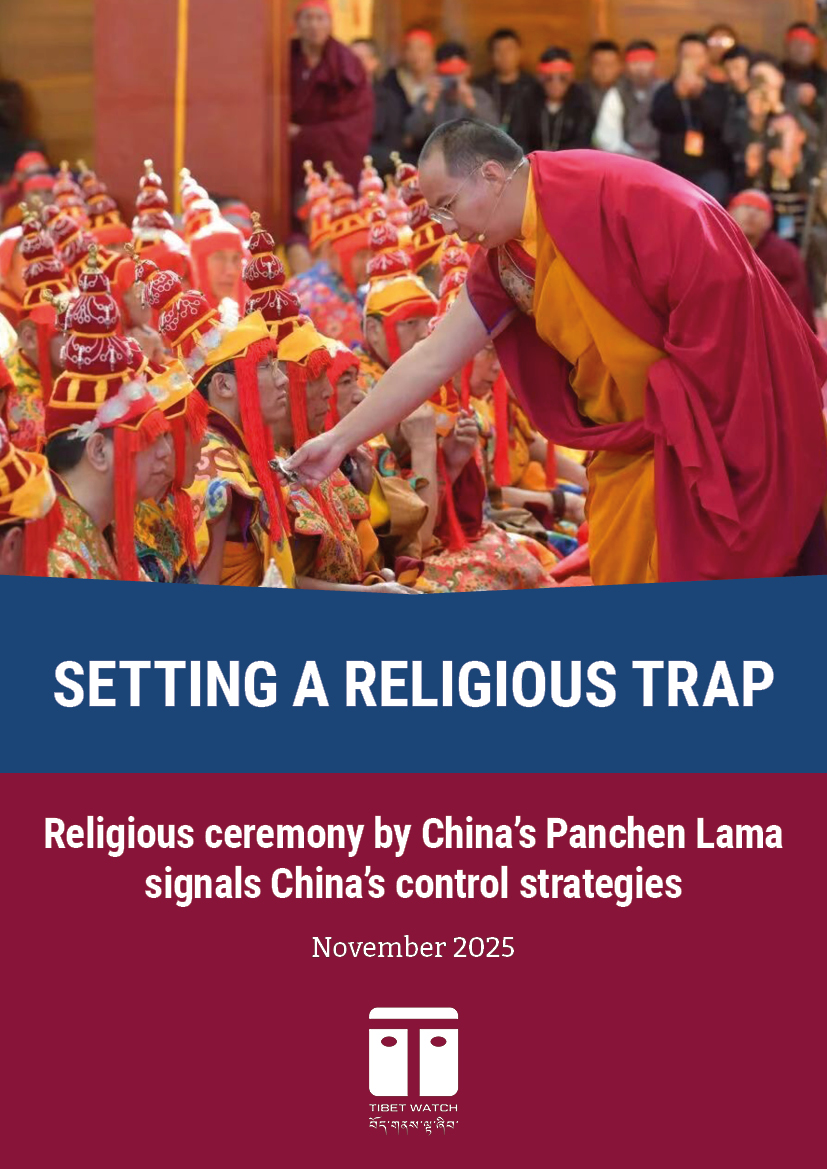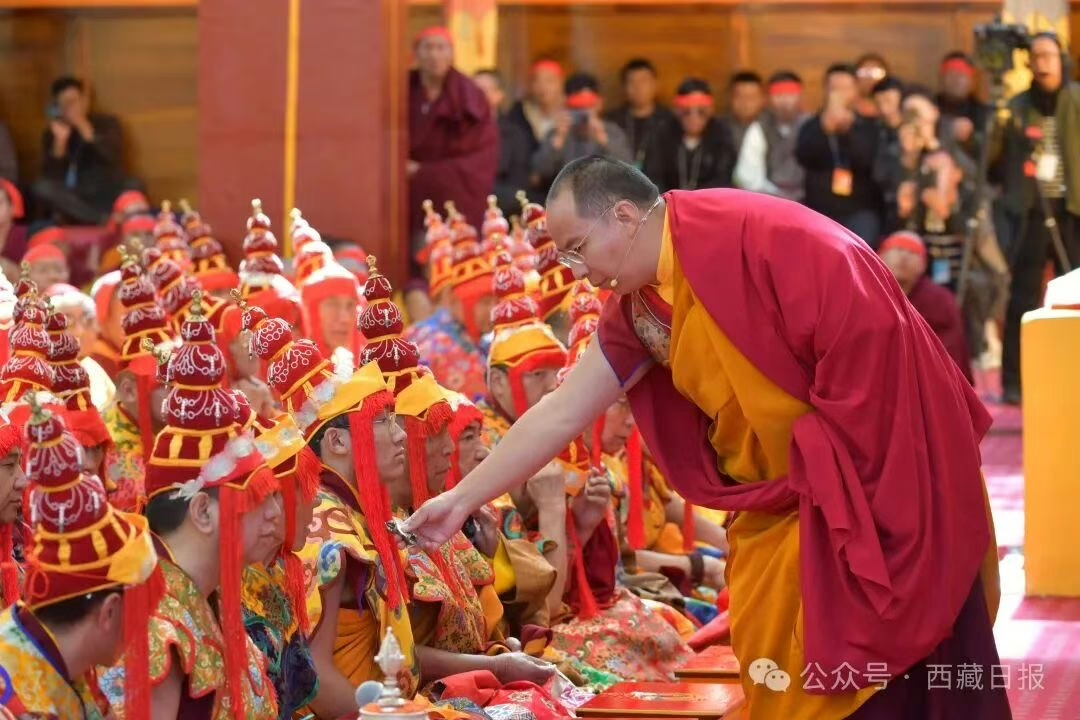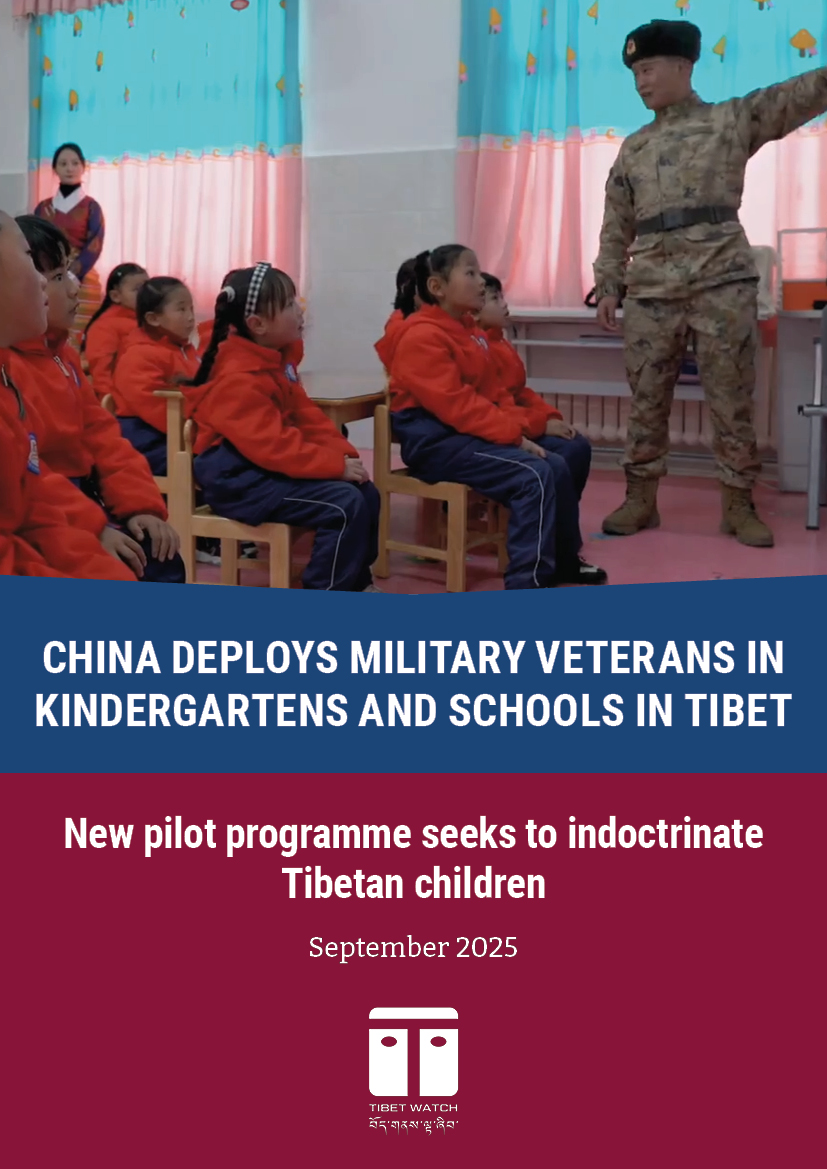
In a new development weaponising sacred Buddhist rituals for political control, the Chinese government-installed Panchen Lama conferred a major religious empowerment in Shigatse, involving monks and prominent Buddhist lamas from across Tibet.
On 9-12 October, Gyaltsen Norbu, Beijing’s appointed 11th Panchen Lama, led a four-day Kalachakra empowerment – one of the most sacred initiations in Tibetan Buddhist practice – at Tashi Lhunpo monastery in Shigatse.
The carefully choreographed event at Tashi Lhunpo monastery, the seat of the Panchen Lama’s incarnation line, constitutes a deliberate step in China’s decades-long campaign to seize control of Tibetan Buddhism’s unique tradition of reincarnation, including the Dalai Lama’s, and erode Tibetan Buddhism through its policy of ‘Sinicisation.’ China has intensified its campaign to eliminate the Dalai Lama’s influence in Tibet, regarding control over his succession as a ‘protracted war’ crucial to maintaining its grip on a strategically vital region.
By requiring prominent lamas and monks from across the Tibetan plateau to attend and receive this empowerment, China is aiming to confer credibility on a state-imposed religious leader, and to forge teacher-student bonds that could prove instrumental in future when China attempts to install its chosen candidate as an imposter 15th Dalai Lama.
“China is setting a religious trap,” a Tibetan monastic source told Tibet Watch. “These sacred teachings create unbreakable bonds between master and student in Tibetan Buddhism. Beijing is forcing this ceremony now so that when they install their hand-picked Dalai Lama, Tibet’s religious leaders will be bound by their own spiritual commitments to remain silent.”
During the ceremony, attended by thousands of laypeople, monks and nuns, the Chinese-installed Panchen Lama Gyaltsen Norbu (Chinese transliteration: Gyalcain Norbu) provided “in-depth explanations of systematically promoting the Sinicization of Tibetan Buddhism and upholding the principle of adapting religion to socialist society”, according to the official newspaper Tibet Daily.[1] These euphemistic terms obscure Xi Jinping’s intensified policies focusing on forced assimilation of Tibetans and the creation of a single Chinese national identity.
Before his high-profile visit to Lhasa in August, Party Secretary Xi Jinping lectured Gyaltsen Norbu – who is not regarded as legitimate by most Tibetans – about the need to do more to promote “the principle that religions in China must be Chinese in orientation” and to further the Chinese Communist Party’s strategic objectives.[2]
Chinese state media reported that more than 100 high-ranking Buddhist lamas and 5000 monks and nuns from major monasteries across the Tibet Autonomous Region, Sichuan, Gansu, Qinghai, and Yunnan provinces attended the Kalachakra ceremony. Prominent religious figures included the Eighth Shartsang Rinpoche, head of Rongwo Monastery in Amdo and the Seventh Gungthang Rinpoche (Lobsang Gelek Tenpi Kechen).
Tibetan media reports have cited sources in Tibet as saying local Tibetans were forced to attend the ceremony, with each family in the area being required to send at least one member to boost the crowd even though it was a busy harvest season. Official reports stated that it was held on “a spacious grassland south of the Panchen Lama’s new palace, Dechen Gesang Podrang” at Tashi Lhunpo.[3]
It is the second Kalachakra ceremony at Tashi Lhumpo conducted by Gyaltsen Norbu, who conferred the first empowerment in the Tibet Autonomous Region in July 2016. Although China promoted the latter as the first such ceremony to be held in Tibet since the Dalai Lama escaped into exile, some Kalachakra teachings have been permitted in Tibetan areas outside the TAR in recent years, attracting hundreds of thousands of Tibetans. In 2015, Jamyang Gyatso, a religious teacher at Labrang Tashikyil monastery in Amdo, who is a tutor to Gyaltsen Norbu, conferred a Kalachakra initiation which was attended by more than 110,000 people from across the Tibetan plateau.

The Chinese government-installed Panchen Lama conferred a major religious empowerment in Lhasa on 9-12 October, involving monks and prominent Buddhist lamas from across Tibet. Gyaltsen Norbu, Beijing’s appointed 11th Panchen Lama, led a four-day Kalachakra empowerment – one of the most sacred initiations in Tibetan Buddhist practice – at Tashi Lhunpo monastery in Shigatse, in a new development weaponising sacred Buddhist rituals for political control. Image: Tibet Daily, 14 October.
An abrupt end to a Kalachakra as sand mandala destroyed
In July 2023, Chinese authorities abruptly put an end to a government-approved Kalachakra gathering in Samey-shi Village, Gumong (Ch: Guomaying) Town, Mongra (Ch: Guinan) County, Tsolho Tibet Autonomous Prefecture, Qinghai. The police arrived at the peak of the initiation ceremony on the morning of 18 July, and forced the departure of His Eminence the Seventh Athi Kalsang Tashi Gyatso, who was to give teachings on the Kalachakra (Wheel of Time). They detained its organisers, dispersed thousands of Tibetan Buddhist pilgrims, and prematurely destroyed the sand mandala created for the ceremony by washing it away with water, leaving all the farmers and nomads – especially elderly attendees – who had traveled from afar in tears and deep anguish.
The construction of a sand mandala, a complex sand-based art involving rituals of Tantric Buddhism to build a two-dimensional palace for hundreds of deities, lies at the heart of the Kalachakra teachings. Although it takes several weeks to construct, devotees wait to catch a glimpse and blessing of the mandala before it is dismantled at a specific moment, accompanied by rituals and prayers to remind one of the Buddhist doctrine of impermanence, and the sand is released into a river.
Another Kalachakra gathering scheduled to take place in that same month in another area of Tibet was temporarily cancelled, but allowed one month afterwards. In a rare mass gathering in September 2023, the Seventh Gungthang Rinpoche – who attended Gyaltsen Norbu’s October teachings on Kalachakra – conferred a religious empowerment in the grasslands of Dzoege near to Tsoe City (Chinese:Gannan), Gansu in the eastern Tibetan region of Amdo. The current Gungthang Rinpoche is the reincarnation of a well-known Tibetan lama who endured years in prison during the Cultural Revolution and survived to lead a revitalisation of Buddhism across Tibet during the period of relative liberalisation that followed. Permission for this ceremony was likely to have been granted because he has many Chinese as well as Tibetan followers.
While compelling Tibetans to attend Chinese Panchen ceremony, China blocks Tibetans from Kalachakra in exile
At the same time as promoting the Kalachakra by their appointed religious figure in Shigatse, China has systematically blocked Tibetans from attending Kalachakra ceremonies led by the Dalai Lama in exile. After his 2012 Kalachakra in Bodh Gaya, India, China abruptly summoned numerous Tibetans from Tibet to return, only to detain and subject them to forced “patriotic education” programs, with some held for prolonged periods. In 2014, a Kalachakra ceremony by the Dalai Lama in Ladakh, India, was described by the Chinese state media in harsher language than before, accusing him of “inciting hatred, terror and extremist action” – rhetoric connecting religious observance to counter-terrorism narratives. The authorities linked their attempts to prevent Tibetans from attending the Dalai Lama’s teachings in exile with ‘counter-terrorist’ work in the ‘frontline’ border areas of Tibet, including Ngari (Chinese: Ali) in the Tibet Autonomous Region, which borders India.[4]
China’s instrumentalisation of the Panchen Lama succession illustrates its broader approach. In the past, it was possible for Tibetans to seek advice from the exiled Dalai Lama about the selection of reincarnate lamas. But this policy ceased in 1995 when the Chinese authorities chose their own candidate as Panchen Lama and abducted the boy recognised by the Dalai Lama, Gedhun Choekyi Nyima. His whereabouts is still unknown. Since then China has institutionalized its control through imposing measures that criminalise any individual or entity other than the Chinese state from identifying or selecting the reincarnation of a Tibetan Buddhist leader.
The symbolism of the Chinese Panchen Lama’s role in any future succession process was underlined when Gyaltsen Norbu visited the ‘oracle lake’ of Lhamo Lhatso in 2018, a sacred site connected both to the reincarnation of the Dalai Lama, and to the Panchen Lama who was recognised by the Dalai Lama, Gedhun Choekyi Nyima.[5]
The Chinese-installed Panchen, Gyaltsen Norbu, is a critical figurehead in plans for managing the Dalai Lama’s succession and has been spending more time in Tibet recently, such as a lengthy visit to the plateau at the same time as Xi Jinping in June 2024, and now this summer coinciding with Xi’s visit to Lhasa. Carefully managed public appearances and statements aim to raise Gyaltsen Norbu’s profile in the secular as well as the religious sphere including visits to strategic sites such as large-scale hydro projects in areas of high seismic activity, representing high risks downstream,[6] and heavily securitised new settlements close to Tibet’s border with India. On one visit to the border areas in 2019, Gyaltsen Norbu visited Jaggang, Ngari (Chinese: Ali) near Demchok in Ladakh, India, one of a number of areas described as ‘disputed’ by Beijing on the ‘Line of Actual Control’ (LAC) stretching from eastern Ladakh to Arunachal Pradesh in India.[7]

The Chinese government-installed Panchen Lama conferred a major religious empowerment in Lhasa on 9-12 October, involving monks and prominent Buddhist lamas from across Tibet. Gyaltsen Norbu, Beijing’s appointed 11th Panchen Lama, led a four-day Kalachakra empowerment – one of the most sacred initiations in Tibetan Buddhist practice – at Tashi Lhunpo monastery in Shigatse, in a new development weaponising sacred Buddhist rituals for political control. Image: Tibet Daily, 14 October.
China’s Panchen as part of a ‘strategic’ and ‘historic’ opportunity to end Western support for Tibet
Policy papers and statements in Chinese official media present Gyaltsen Norbu’s role in the context of what they term a ‘strategic’ and ‘historic’ opportunity to end Western support for Tibet and to fragment the Tibetan exile movement in a “post Dalai Lama era”. Some Chinese commentators acknowledge that the process will not be easy. “Concretely speaking, we must mould him into a spokesman for Tibetans’ interests and a senior lama who promotes Buddhism, and not just a ‘mouthpiece’ for Love the Country, Love the Religion [a Party campaign, which effectively means the central importance of loyalty to the CCP for all religious practitioners],” wrote Wang Yanmin from the Public Security University of China in a paper regarded as influential in Beijing. “Such positioning would not only be beneficial to strengthening the Panchen’s authority domestically, particularly among believers in Tibetan areas, but also under conditions when the time is right, there is also the possibility that he could fill the ‘vanished idol’ role created by the West after the Dalai dies. There will be great difficulty in achieving this goal […].”[8]
China’s Panchen Lama Gyaltsen Norbu has been associated with the anti-Dalai Lama Shugden (Dolgyal) sect since his installation, and China aims to make him a rallying point for those who practice Shugden worship.[9] The Dalai Lama has requested those who wish to practice this form of worship not to attend his teachings, as he believes them to be a sectarian divisive force.
Although since his enthronement Gyaltsen Norbu has met three successive leaders of China,[10] he has little political weight. When he appears with senior Party leaders such as the head of the United Front or the TAR Party Secretary he is usually portrayed as a passive figure who is subject to exhortations to follow ‘Xi Jinping thought’.[11] The highest position he holds is one of five Tibetans on the 299-member Chinese People’s Political Consultative Committee Standing Committee.[12] Party scholar Xiao Jie was typically dismissive in comments cited by the Global Times: “I don’t see him having a more important role … the policy to separate religion from politics has been successful [in Tibet]. […] I don’t think religious figures will play a major role in [Beijing’s] Tibet policies. [These] are developed under the leadership of the Communist Party – I don’t think we need him [in politics].”[13]
Nevertheless, Gyaltsen Norbu is a critical figurehead in plans for managing the Dalai Lama’s succession. As part of this strategy, Party propaganda projects Gyaltsen Norbu as more important and legitimate in the Tibetan Buddhist hierarchy than the Dalai Lama.[14]
Nepal blocks Chinese Panchen from visit
China’s efforts to create an international profile for their official Panchen were hindered in May 2022 (and possibly also in December 2024) when he was refused permission to visit Nepal. The Chinese Communist Party had planned for him to attend a ceremony in the Buddha’s birthplace in Lumbini, but both the United States and the Indian government expressed alarm. A visit by China’s Panchen Lama would have been a significant propaganda coup for the People’s Republic of China (PRC) as part of their effort to dominate India’s Buddhist heritage at a symbolic sacred site close to its border, as well as a stepping stone towards further travel outside the PRC for Gyaltsen Norbu.
Chinese Communist Party-aligned Mongolian monks have also invited China’s Panchen to visit Mongolia, which would serve the purpose of undermining the Dalai Lama’s influence and potentially creating divisions among the Tibetan Buddhist community in Mongolia.
By compelling prominent lamas to receive empowerment from its appointed Panchen Lama, by systematically suppressing independent religious practice while showcasing state-controlled ceremonies, and by institutionalizing its authority over reincarnation itself, the Chinese Communist Party seeks nothing less than the fundamental transformation of one of the world’s most comprehensive and philosophically rigorous religious traditions.
Tibetans loyal to Dalai Lama-recognised Panchen Lama and predecessor
Yet three decades after his installation, Gyaltsen Norbu commands neither the genuine reverence nor the spiritual authority of the lineage he is meant to uphold. Despite the irony of Xi Jinping telling him in June this year to follow the example of the 10th Panchen Lama, Tibetans still pray with the 10th Panchen Lama in mind, who died in January 1989.
Tibetan refugee Pema Rinzin said: “In the Tashi Lhunpo Monastery, a picture of the previous Panchen Lama and the current Chinese-appointed reincarnation, Gyaltsen Norbu, is on display. But the Tibetans pay respect to the previous Panchen Lama [10th Panchen Lama] and not the Chinese Panchen Lama.”[15]
A Tibetan Buddhist monk now living in exile in India told Tibet Watch: “There was a portrait of Chinese-recognised Panchen Lama on the main throne of the Tashi Lhunpo Monastery, though he was not staying there at the monastery. I went past the throne and visited the bedroom of the previous Panchen Rinpoche, and his memorial stupa. Then I went back to Lhasa and planned my escape journey from Tibet.”
The Kalachakra ceremony at Tashilhunpo demonstrates the lengths to which China must go – and the elaborate constructions it must create – because it lacks what cannot be manufactured or compelled: genuine spiritual authority and the faith of the Tibetan people in Buddhism.
Endnotes:
[1] Weixin (Wechat) post, 14 October 2025, https://mp.weixin.qq.com/s/Lw-lDgoNOOJJD1B0yOl17A
[2] Xi Jinping hosted the Chinese Panchen Lama Gyaltsen Norbu in Beijing on 6 June, together with top Party ideologue Wang Huning, a key architect of China’s Tibet policy, and who travelled with Xi to Lhasa. Xinhua News Agency, 6 June 2025, https://english.news.cn/20250606/f21ff7f8866b46e4b2b0fcf132df3c9c/c.html
[3] Weixin (Wechat) posts, 6 October 2025, https://mp.weixin.qq.com/s/ZyLQav4blyfm5e02-IfELg & https://mp.weixin.qq.com/s/oxk0zu9hFRQZdIM3Qkt99A
[4] In line with their broader political objectives of undermining the influence of the Dalai Lama, the Ngari authorities stepped up border security just prior to the Kalachakra in Ladakh from 3-14 July 2014. At a conference in Ngari on 2 September 2014, officials asserted the “key importance” of counter-terrorist work across Tibet but in particular in the border, ‘frontline’, areas. The article in the state media reported comments at the meeting by Dorjee Tseten, Vice Chairman of the TAR and He Wenhao, the deputy secretary of the Regional Party Committee Political Committee. Ngari Prefecture Government Website, 4 September 2014, https://web.archive.org/web/20140913032322/http://www.xzali.gov.cn/tv/10314.jhtml [Retreived via archive 4 October 2025]
[5] Xinhua News Agency, 20 August 2018, http://eng.tibet.cn/eng/news/tibetan/201808/t20180820_6189684.html [Cited in International Campaign for Tibet report, 11 September 2018, https://savetibet.org/china-tightens-screws-on-tibetan-buddhism/]
[6] For instance he has been photographed at the enormous Zam (Chinese: Zangmu) dam in Lhokha (Chinese: Shannan), the largest hydropower station in the TAR.
[7] “11th Panchen Lama Visits Rural Families.” China Tibet Online, 7 August 2019, http://eng.tibet.cn/eng/news/tibetan/201908/t20190807_6656885.html
[8] Wang Yanmin, ‘A study of new changes in Tibet independence splittist activities in the post-Dalai era and countermeasures’, MA Dissertation, Public Security University of China, 7 April 2017, https://web.archive.org/web/20211221171904/https://wap.cnki.net/touch/web/Dissertation/Article/10041-1017861373.nh.html [Retreived via archive 4 October 2025]. Translation available at https://tibetnetwork.org/geopoliticsoftibetsreincarnation/
[9] Further details available at ‘Sacred Authority and State Power: The future of the Dalai Lama institution in an international context (part one)’, Turquoise Roof, 24 June 2025, https://turquoiseroof.org/download/sacred-authority-and-state-power-part-one/
[10] Jiang Zemin, Hu Jintao, and Xi Jinping. According to state media, “This shows that the Party Central Committee has consistently given a high level of attention to Tibet.” “Why Did Xi Jinping Meet with the Panchen Lama Just Now?” Xinhua News Agency, 3 December 2015, http://m.tibet.cn/eng/opinion/analysis/201512/t20151203_5763522.html
[11] In a typical such example, current Vice Premier (then head of the United Front Work Department) Sun Chunlan was pictured in the state media meeting Gyaltsen Norbu on 1 March 2016 and saying that she hoped he would “keep in mind the exhortations of Xi Jinping […] and to consciously safeguard the unity of the motherland and national unity […], playing an active role to lead Tibetan Buddhism to adapt to the socialist society.” Xinhua News Agency, 2 March 2016.
[12] Some observers expected that he would be appointed at least as a Vice Chair of the CPPCC, according to the International Campaign for Tibet. “Buddhist Association of China Takes a Leading Role in China’s Attempts to Control and Forcibly Reshape Tibetan Buddhism.” International Campaign for Tibet, 29 May 2024, https://savetibet.org/buddhist-association-of-china-takes-a-leading-role-in-chinas-attempts-to-control-and-forcibly-reshape-tibetan-buddhism/
[13] Cited in Josephine Ma, South China Morning Post, 28 September 2020, https://www.scmp.com/news/china/politics/article/3103369/will-chinas-official-panchen-lama-now-30-take-bigger-role-tibet
[14] For instance, a report in Xinhua in 2005 described him as “the highest ranking figure in Tibetan Buddhism” and the “leader of Tibetan Buddhism”.
[15] For in-depth story of Pema Rinzin’s torture in the hands of Chinese police following his brother’s escape from detention, Niharika Mandhana and Josh Chin, ‘The Daring Caper of a Faithful Tibetan who Outfoxed China: He escaped from police and crossed thousands of miles on a decadelong odyssey toward freedom, Wall Street Journal’, Wall Street Journal, 20 September 2025, https://www.wsj.com/world/asia/tibet-china-dalai-lama-78ecc180

